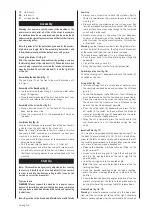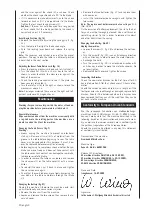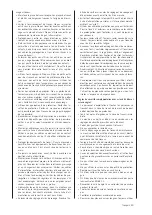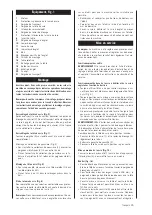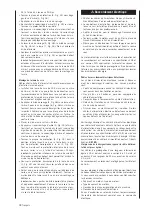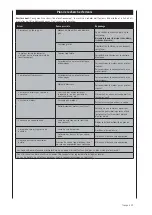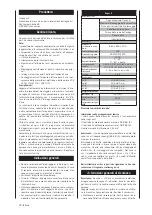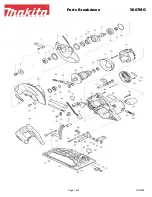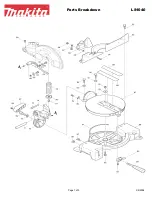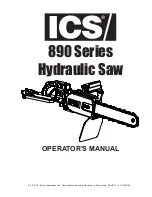
18 english
Danger: The laser is activated when the saw blade turns.
Do not look into the beam, even with optical instruments.
Do not remove the warning sign which is attached to the
saw blade cover. Avoid direct eye contact with the light
source.
Note:
The red laser beam appears as a dotted line when
the motor is activated and the saw blade Is in the highest
position. This dotted line allows you to adjust the markings
on the materials with the cutting line of the saw blade.
When the saw blade is brought downward, the protection
is removed and the dotted line becomes a continuous laser
beam.
Laser Warning Sign: Maximum output <1 mW Diodenlaser:
630 – 670 nm. Corresponds to the standard EN608251.
Laser Operation
With the saw blade unit in the most upright position:
• Place your materials on the mitre box saw.
• Switch the saw on to activate the laser beam.
• Make sure that the laser beam and the markings on your
materials are in agreement. (
Warning: do not lower the
saw blade during adjustments.)
• Should the markings on the materials and the laser
beam not agree with each other, switch the machine off,
wait until the blade has come to a complete standstill,
and adjust the position of the materials.
• Switch the saw on and recheck the line.
• Once agreement has been reached, fasten the materials
with a screw vice and carry out the cut.
Changing the Saw Blade (fig. 24, 25, 26)
Warning: In order to prevent an unintentional start up of
the saw, always switch off and unplug the machine be-
fore changing the saw blade. Use correctly sharpened saw
blades. Conform to the maximum speed and the tooth type
indicated on the saw blade. Exchange of saw blades and in-
stallation must be carried out correctly. Only use saw blades
of the type recommended in the operating instructions.
Removal of the Saw Blades
• Unplug the machine from the power source.
• Raise the mitre box saw into the upright position.
• Raise the lower, transparent, plastic saw blade cover into
the most upright position (1, fig. 24).
• While holding onto the lower saw blade cover, release
the screw of the cover (2, fig.24) with a Phillips screw
-
driver.
• Turn the cover (3) so as to reveal the frame screw (4,
fig.26).
• Put the blade key on the frame screw.
• Find the corrugated closure and hold this steady while
turning the blade in a clockwise direction. The corrugat-
ed closure will click in and adjust the guard. Continue
to hold the closure while turning the key in a clockwise
direction to release the closure.
• Remove the bracing clamp (5, fig. 26) from the bracing
cylinder (6) and the blade (7). Do not remove the inner
cylinder.
• Lift up the transparent, plastic saw blade protection (1,
fig. 24) to the upright position in order to remove the
blade.
Note:
Pay close attention to the parts which you remove
and the way they were installed. Clean any sawdust away
from the cylinders before you install a new blade. The 254
mm blade has a wave hole with a 16 mm reduction piece
in order to assemble it on the saw.
Installing the Saw Blade
Unplug the machine before changing or installing a saw
blade.
• Install a 254 mm saw blade with a 16 mm wave. Please
note that the directional arrow which points in a clock
-
wise direction and the upper saw blade must be in
agreement on the blade must correspond to each other
and the saw blade teeth have to point down.
• Put the bracing cylinder (4, fig. 26) onto the blade and
the wave. Screw the bracing cylinder (6) to the wave in
an anticlockwise direction. Important: Make sure that
the flat part of the cylinder and the flat part of the wave
shaft lock into each other. Equally, the flat side of the
bracing cylinder must meet the blade.
• Place the blade key into the wave screw.
• Press on the wave closure (5, fig. 25) and hold it tightly
while turning the blade in an anticlockwise direction.
When it clicks in, press the wave closure further down
and turn the bracing screw until it is tight.
• Return the covering plates (3, fig. 24) to their original
position until the slit in the cover is over the screw (2,
fig. 24). While holding on to the lower saw blade lid,
tighten the screw with a Phillips screwdriver.
Note:
The lower saw blade cover must be in the upright
position in order to achieve access to the covering plate
screw.
• Move the transparent saw blade protection cover (1, fig.
24) down and make sure that nowhere does It make con
-
tact with the blade.
• See that the wave closure is released so that the blade
can turn freely. Turn the blade until the closure is re-
leased.
Note:
Both cylinder parts must be clean and properly posi
-
tioned. Put the blade down into the lower table and ensure,
by turning it by hand, that it does not come into contact
with the body of the machine or the mounting table.
m
Electrical Connections
• Check the electrical connections. Do not use damaged
cables. See the section on electric cables.
• Only an electrical specialist should undertake installa
-
tion, repairs and maintenance work on the electric con
-
nections.
• To deal with power malfunctions, switch off the ma
-
chine. Pull out the plug.
• Switch off the motor when you leave the workplace. Pull
out the plug.
• Even when the machine is only being moved a small
distance, unplug it from external power sources! Before
operating the machine again, plug the machine in prop
-
erly!
The electric motor installed in the machine is ready to op
-
erate when it is delivered. The connection corresponds to
the relevant VDE and DIN norms. The customer‘s electri
-
cal connection as well as the extension leads used must
also correspond to these norms or, respectively, the local
electrical standards.
Defective Electrical Connections
Electrical connections can often have insulation deficien
-
cies. Possible causes include:
• Pressure points when the cable is passed through door
or window cracks.
• Bending points due to inexpert binding or laying of elec
-
trical cables.
Содержание 8800 1945
Страница 120: ...118 international 17 ...
Страница 121: ...international 119 ...
Страница 122: ...120 international ...













